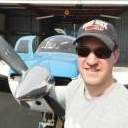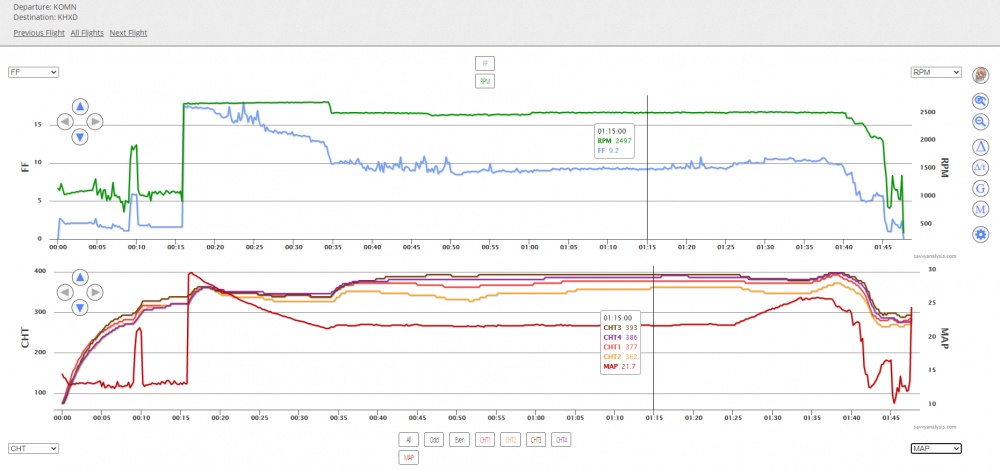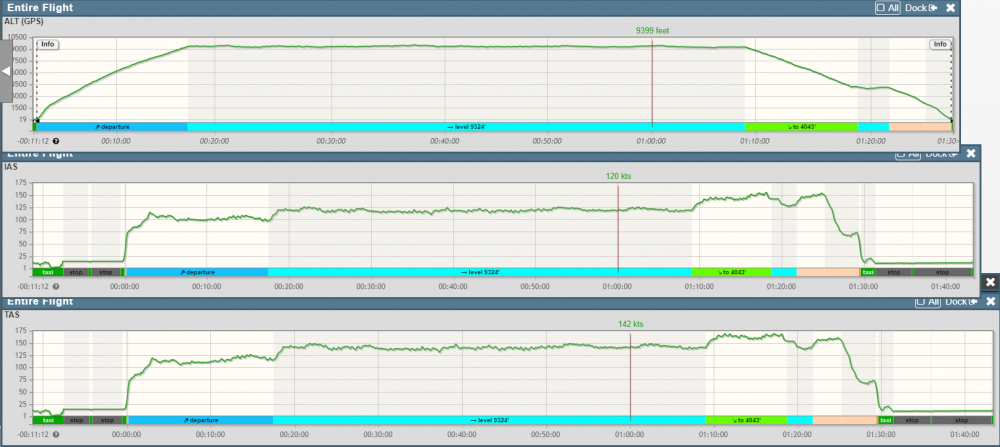-
Posts
43 -
Joined
-
Last visited
Content Type
Profiles
Forums
Blogs
Gallery
Downloads
Media Demo
Events
Everything posted by y2kiah
-

Electro air Electronic Ignition System (6100)
y2kiah replied to donkaye's topic in Mooney Bravo Owners
Ok, I'll start with the good stuff: The EIS gives a strong spark as advertised. During engine run-up the RPM drop is a barely noticeable 20 RPM when the mag is turned off, while running on the mag alone drops the usual 100 RPM. The engine is happy over a very large mixture range including well lean of peak It's cool to have a switch panel and push-button start in place of the key I recently had an in-flight mag failure after 3 hrs of cruising with what turned out to be a slowly dying mag, which led to a loud pop, followed by a very rough engine that was still capable of making some power. Luckily, I did not need to use that power since I was over an airport at the time and simply glided down and landed as if it was an engine failure. I taxied in, did a mag check, and confirmed that the mag was dead. I wondered why running on the EIS was so rough, since under most circumstances you wouldn't notice any power reduction turning off the mag in flight. As is turned out, the 3hrs of cruise on a faulty mag had fouled up all of the spark plugs pretty bad, and the engine was really unhappy without all of the plugs firing. Cylinder #4 was especially impacted and looked like it was making no power during that event. I was thankful for the strong spark of the EIS. If I had been running on two mags, there is a chance the engine may have failed outright in that condition. Now for some of the bad: Coming right back to the mag failure event, the pucker factor increases when you lose your mag because your engine is now totally dependent on the electrical system. Make sure your alternator and battery are in good condition if you are going to install the EIS. If you have the option to install backups for either, I would recommend it. Secondly, I wonder if the strong spark of the EIS led to the engine running smooth enough over 3 hours as the mag was dying, that it was hiding early warning signs of the impending failure. If I had been running on two mags, maybe I would have noticed a decrease in power or roughness earlier in the flight, and ended the flight before the total failure, and under safer conditions. Why did #4 lose almost all power, while the the others continued to operate? The bottom plugs on 2 and 4 run from the EIS. Those likely fouled up more than the top (EIS) plugs on 1 and 3. The lead wire connections were designed for automotive plugs and are too flimsy for aircraft engines. There is no mechanical clamping, they rely on friction alone to keep the wire in place compressing the spring. As the wire ages, the friction decreases and the connections have a tendency to slip, leading to loss of contact with the plug. I had to replace one of my lead wires because the connection kept slipping out in flight. All of that voltage has to go somewhere. It ended up shorting and burned a hole through the side of the wire insulation (within the plug). This has apparently been a common problem with the Electroair. It was not a cheap fix. The system is unfamiliar to a large number of mechanics out there. I had a mechanic (not at my home shop) tell me the gap on my plugs was too big, until I reminded him that the EIS uses different plugs with a larger gap. Make sure you are very familiar with the system and double check for correct plug installation after any maintenance. You have to cram another system and all of its wiring onto your firewall, where space is already tight. Changing the oil filter on my J with all of that extra stuff in the way is a real hassle. Not sure how that would impact a Bravo. Overall I am happy with the system, it works very well if all of the components are healthy. My take is that you are not relieved from the burden of mag maintenance, or the risk of mag failure, so I would not factor that into the decision too heavily. If your remaining mag does fail, the failure mode of your engine changes as compared to running two mags. You'll probably also have some new maintenance items pop up from time to time. -

Electro air Electronic Ignition System (6100)
y2kiah replied to donkaye's topic in Mooney Bravo Owners
I have an Electroair and could give a pirep, but it's on a J, not a Bravo... -
OK! I'll talk! In third grade, I cheated on my history exam. In fourth grade, I stole my uncle Max's toupee and I glued it on my face when I was Moses in my Hebrew School play. In fifth grade, I knocked my sister Edie down the stairs and I blamed it on the dog... When my mom sent me to the summer camp for fat kids and then they served lunch I got nuts and I pigged out and they kicked me out... But the worst thing I ever done - I mixed a pot of fake puke at home and then I went to this movie theater, hid the puke in my jacket, climbed up to the balcony and then, t-t-then, I made a noise like this: hua-hua-hua-huaaaaaaa - and then I dumped it over the side, all over the people in the audience. And then, this was horrible, all the people started getting sick and throwing up all over each other. I never felt so bad in my entire life.
-
"Blue Moon" named by my daughter
-
Yes I mean LOP. It's not unrealistic for a high power cruise. I can see as high as 150 indicated down low and at high power, but that is not a realistic cruise in my experience.
-
MojoGrip's terrible video aside, I have a '78 J and 135 KIAS is very much in line with what I see for cruise speeds at altitude. 135 knots indicated is 132 CAS. Converted to TAS at 8000 ft on a standard day, that is 149 KTAS. Taking winds aloft into account, you will more often than not see ground speeds in the 140's range. Now let's say it is a hot Florida summer day, and the ground temperature is 32 C. That would equate to roughly 18 C at altitude, but that is also a density altitude of over 10,000. I can expect to see around 130 KIAS in those conditions, which is a CAS of 127 and a TAS of 148. At 2400-2500 RPM, I would typically see a fuel flow of 9.2 to 9.6 which is at or slightly below peak EGT, where I prefer to set my mixture. If I go much leaner, the speed drop-off really starts to get depressing, although the fuel flows do drop into the mid 8 gph range. I don't expect that my J is as fast as 201er's with his beautiful new paint, and my rigging issues, but I think 150-160 TAS range is an optimistic stretch for a J. You could probably get those speeds at a lower DA, but that would be very high power cruise and a high fuel flow to match. I would have trouble keeping my cylinders at or below 400 under those conditions. This is just one J owner's perspective. Let the flood of negative feedback begin!!
-
I don't think it's been mentioned... the "laminar flow wing" is another myth you hear all the time. And also the "tail on backwards" thing - not so much a myth, but definitely a line you always hear, as if the design was not deliberate.
-
I can barely decide on what to have for dinner as quickly as the market turns over nice airplanes
-
As explained to me (by my IA) some of the lobes on the shaft do double-duty in spots where the horizontally opposed valves align, and those lobes are subject to increased wear and are usually the ones found worn prematurely. If you throw pitting due to corrosion into the mix, it will only accelerate the effect.
-

Fuel pressure gauge pegged-M20J
y2kiah replied to wingsaircharter's topic in Modern Mooney Discussion
Mine is the same way. Both my old one and my new one, actually. You might want to consider leaving it alone. When I told my shop (a good MSC) about the last one being pegged constantly, I was told the gauge was "shot". After the shop messed with it and did whatever it was they did, it never worked again, so it went from being pegged to the right, to being pegged to the left and marked "inop". I don't know about you but I will take pegged to the right over pegged to the left any day. I then went on the hunt for the right gauge that would match my particular cluster from my particular serial number range. After spending about 1.5 AMU and 6 months on this project, I ended up with a "new to me" gauge that is still always pegged to the right. Well... every now and then it blips down into the mid range. What serial# is your J? I have an extra cluster laying around and if it happens to match the one you need, I will send it to you to try it out. I know how frustrating it can be to locate these. If it works out, you can pay me for the gauge and keep it, if not you can send it back. Edit: I should clarify, master on/off and engine running/not running does show a difference on mine. If yours is really pegged to the right at all times, you have a different problem and it is truly inop. -

Chicago... airport recommendations
y2kiah replied to Bob_Belville's topic in Miscellaneous Aviation Talk
I just flew IFR in and out of Midway a couple weeks ago. The controllers were great and the nice folks at Atlantic gave me a ride into the city (it was a Sunday and things were slow). I do recommend it, just expect a few reroutes as they work you in. On the way out I took the train and then hiked through the terminal to catch a taxi to the FBO. I don't do Uber or Lyft or Ryde or Busss or Weel or any of that. -
I’m going to try this tonight.
-
Thanks Skip, I'll check #3 for the JPI probe, it always reads hotter LOP, but ROP the other cylinders catch up and can actually overtake it. This makes me think that #3 is running richer than the others. I am pretty sure rigging has a lot to do with it. My left flap, when up, rests in a reflexed position with respect to the top wing surface, while the right flap is on a correct plane for the chord of the wing. This leads to a need for constant left rudder pressure to keep the ball centered at cruise and especially descent airspeeds. I also have a badly heat-cracked cowling that must be adding some drag. Rigging is on my short list of things to fix next.
-
As a point of comparison, I recently did a square pattern to measure TAS in my ‘78 J at 25” 2500 rpm, 2000 ft indicated, about 4K DA (28C oat). I was giving it 11.2 gph to keep cylinder #3 under 400. according to the book, I should have been getting roughly 158ktas with those numbers, my real world TAS was ..... wait for it..... 140. take it for what it’s worth, but I think you should be happy with the performance you are getting. Btw I plan at 140 because it is unrealistic for me to expect more from my plane without burning up the cylinders.
-

WTB 201 Rochester cluster 64028-507 or FP gauge -119
y2kiah replied to y2kiah's topic in Avionics / Parts Classifieds
Thanks Jim, I'll check my current gauge to see if it's a match and get back to you asap, I think this might be the one. -

WTB 201 Rochester cluster 64028-507 or FP gauge -119
y2kiah replied to y2kiah's topic in Avionics / Parts Classifieds
@bluehighwayflyer Jim, that could be it! Do you happen to know the serial # of that airplane? I can look it up in the parts manual to see if it shares the same part. The cluster should be marked as -507 on the sticker. -
I'm a CFII based at KOMN. Also can't say I've flown the GNS 480 although plenty of 430/530 and GTN 750 time. Give me a shout if you can't make it work with the other guys. I head up to KSSI frequently for the Southern Soul BBQ.
-
Member 26, I hope to participate this coming year!
-
Not familiar with the area at all other than what I have read about, but I'm really looking forward to this little vacation with the family. We will be in Asheville at least one of the days. Lots of great options for fly-ins in your area, and that Runway Cafe at GMU sounds perfect, we might just have to stop there on our way back if time permits. Thanks for the info!
-
Nice! I'm heading up that way on Thursday. Going to KFQD - Marchman. I'll give you a pirep of how great the flying was.
-

Lopresti SCRAM MP increase - quick-look data
y2kiah replied to testwest's topic in General Mooney Talk
No shame in that, I might have to borrow your eyes one of these days (since you are right down the street from me) to help figure out why my bird is such a lead sled. -

Lopresti SCRAM MP increase - quick-look data
y2kiah replied to testwest's topic in General Mooney Talk
I've worked it out by calculation, observation of actual ground speeds and analysis by Cloudahoy. All of them point to my lower-than-average numbers. I get about 120 indicated up at 8500. 135 KIAS down low. I would need something more like 135 up at cruise to get a true of 155. Here is a recent snap from cloudahoy correlated to my JPI data: In short, I could sure use a speed mod like the Lopresti cowl / SCRAM, but I seem to be starting from way behind the curve. I have a few hunches that bad rigging, chipped paint, badly cracked cowl, and less than perfect fairings leading to a loud humming at cruise speeds are all contributing to this. I didn't realize it was so bad though, yikes. -

Lopresti SCRAM MP increase - quick-look data
y2kiah replied to testwest's topic in General Mooney Talk
I really don't know how these speeds are being achieved, my J is a 140 KTAS airplane flying LOP at 8.6 to 9 GPH. MAYBE I would see 150 flying best power but I don't operate that way. Something must be wrong with my airplane...





